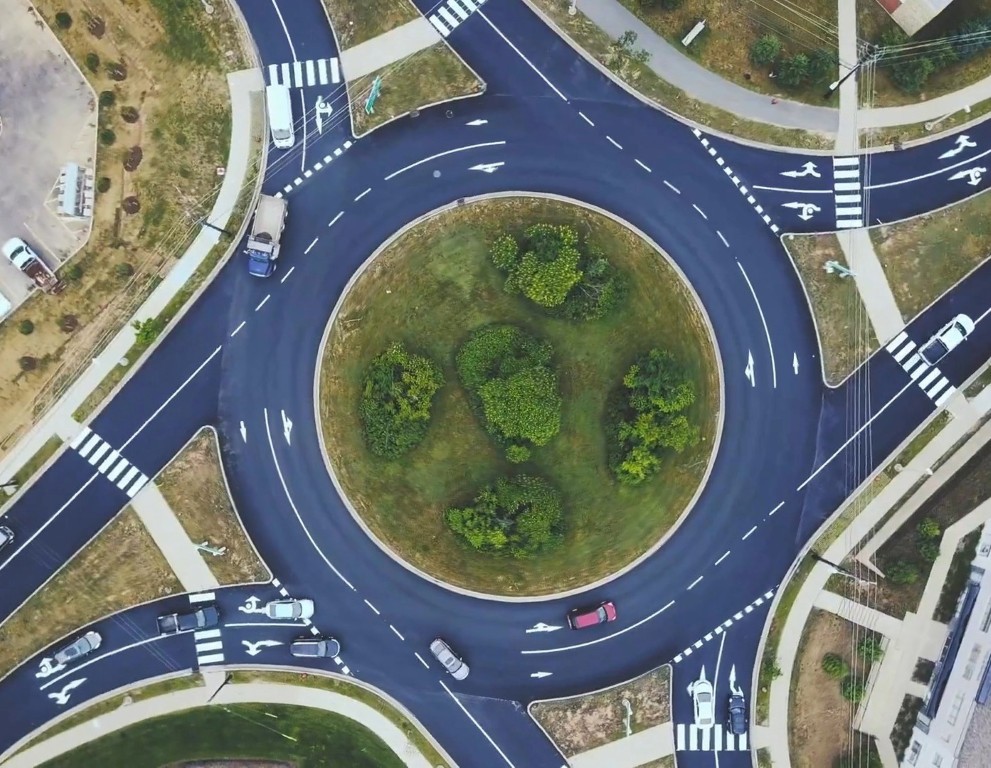If it feels like roundabouts are popping up more often on Kentucky roads, you’re not imagining things. Communities across the region and the country are rethinking how intersections work. In many cases, they’re choosing roundabouts over traditional traffic signals or stop signs. The reason is straightforward: roundabouts improve safety, reduce congestion, and often save money in the long run.
David Johnson, Senior Traffic Engineer at BFW/Marcum, has seen this shift firsthand through projects across the region. He says the movement isn’t just about appearances. It’s driven by performance.
“Roundabouts can improve safety, reduce travel delay, and work well in many different scenarios,” Johnson said.
A Safer Intersection
One of the primary reasons for the rise of roundabouts is safety. Traditional signalized intersections have 32 vehicle conflict points. Roundabouts have just 8. Pedestrian conflict points drop from 24 to 8 (source).
“Roundabouts reduce driver speeds and reduce conflict points,” Johnson explained. “That means fewer crashes. And when crashes do happen, they’re usually less severe.”
High-speed T-bone crashes are common at signalized intersections while roundabout design largely eliminate them.
Reducing Delay, Easing Congestion
Roundabouts also help with traffic flow. Johnson notes that they often result in lower delays than stop-controlled or signalized intersections. When operating within capacity, roundabouts manage traffic more efficiently, especially during off-peak hours.
“When roundabouts operate within their capacity, they tend to offer lower delay to vehicles than traffic signals operating with the same traffic volume,” he said.
A study from the Federal Highway Administration found that roundabouts can reduce delays by up to 65% compared to traditional intersections.
The Right Fit for Complex Traffic
Roundabouts are effective and versatile. Johnson says they excel at managing speed when transitioning from high-speed to low-speed roads. Examples include interstate ramps and rural intersections.
“Roundabouts are great at ‘tricky’ intersections,” he said. “They’re especially useful when roads meet at odd angles or when there are more than four approaches.”
Clearing Up Misconceptions
Despite the benefits, roundabouts still face resistance from the public. One common misconception is that they are confusing for drivers. Johnson recommends that hesitant drivers check out Federal Highway Administration tutorials. He points to this video as a good starting point. Key takeaways from the video include:
- Always yield to traffic already in the roundabout.
- Look left before entering, not right.
- Do not stop inside the roundabout unless necessary.
- Use your right turn signal to exit.
- Pedestrians have the right of way at crosswalks.
- Cyclists can ride with traffic or use the sidewalk if available.
Another concern is cost. Roundabouts can appear more expensive because they often require more space at the intersection itself. However, Johnson explains that signalized intersections usually need more right-of-way on approach roads due to additional turn lanes.
“Signals need turn lanes, engineering for timing, and long-term maintenance,” he said. “Roundabouts take up more space at the intersection. But signals require more infrastructure leading up to it. In many cases, roundabouts are more cost-effective over time.”
Designing with Safety in Mind
Modern roundabout design also takes pedestrians and cyclists into account. Johnson points out that pedestrian crossings include refuge islands. These islands allow people to cross one direction of traffic at a time. For cyclists, engineers include shared-use travel lanes or provide ramps to separate shared-use paths.
“Roundabouts offer fewer pedestrian-vehicle conflict points than traditional intersections,” he said. “Lower speeds reduce the risk of serious injuries or fatalities.”
The Insurance Institute for Highway Safety reports that roundabouts reduce injury crashes by 75% compared to traditional intersections (source).
From Planning to Implementation
Johnson has led several roundabout design projects in southeast Missouri. These include the intersection of Route Y and Route BB near Sikeston, Missouri, and the MO 51 and Alma Avenue intersection in the town of Perryville. Each of these projects required careful planning, coordination with local agencies, and a tailored design to meet the unique traffic demands of the area. He emphasizes the importance of using tools like FHWA guides, traffic simulation software, and AASHTO spreadsheets to make sound engineering decisions.
“Best practices include referencing FHWA guides and simulation tools during the design process,” he said.
Design considerations include existing and future traffic volume, crash history, right-of-way availability, property access needs, and the geometry of the intersection. Emergency vehicle access and coordination with nearby traffic signals or rail crossings are also part of the equation.
For Communities on the Fence
When a community is hesitant about installing a roundabout, Johnson suggests using traffic simulation tools which show how the intersection would function with the change. They also compare current conditions to projected improvements in flow and safety.
“We can show how traffic is performing now and how much smoother it will be with a roundabout,” he said.
Often, it comes down to safety. If an intersection has a crash history that includes injuries or fatalities, the case for a roundabout becomes stronger.
“Once communities see the results, they usually come around,” Johnson said.


Recent Comments